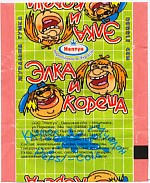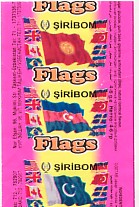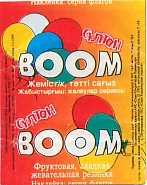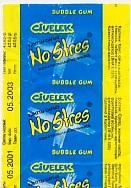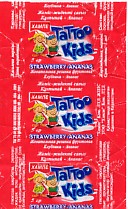CHEWING GUM COMPANIES IN THE URSS, RUSSIA AND CIS
CHEWING GUM COMPANIES IN THE URSS, RUSSIA AND CIS
Before the WW2 nobody in the Soviet Union has
ever heard of chewing gums except for a few high-rank officials in the
People's Commissariat for Foreign Affairs, who had a rare opportunity to
travel abroad.
The word as it is was actually introduced to Russian soldiers by their American allies in spring of 1945, but soon after that the period of so called "cold war" and "iron curtains" began, and everything related to the Western way of life was forbidden and consequently forgotten in the Soviet Union for years. Even in mid-seventies, after the European countries of communist block had started their own gum production, Soviet propagandists continued to insist that chewing of a gum, especially in public, was a symptom of bourgeois decadence.
But so far the economic and particularly military ties between the USSR and its allies in Europe had to be maintained, hundreds of Soviet specialists and thousands of troops were regularly sent to GDR, Hungary, Poland, Czechoslovakia and Bulgaria. Apart from the stories about the life beyond the border and souvenirs for their friends, they brought home special coupons to be used for purchasing foreign goods at Beryozka stores for themselves and, of course, sweets and chewing gums for their kids.
Though GDR-made gums could not be in any way compared to those produced by Wrigley or Adams, practically they were the only and therefore very precious gums available to Russian children at the time.
The situation started to change after the International Olympic Committee's decision of 1976 to hold the next summer Olympic games in Moscow in 1980. The Soviet government decided to do its best to let the foreign guests feel themselves as comfortably as they were accustomed to at their homelands. Besides good roads, air conditioners, familiar food and drinks, this, of course, included chewing gums as well. The easiest way to ensure it was plain import, but after some consideration the Ministry of Foodstuff Industry was instructed to start the chewing gum production in the USSR. That was the turning point.
The only short period when foreign-made gums were officially
imported to the USSR was the year of Moscow Olympics – 1980. That time
the amazed Muscovites and those lucky Soviet citizens who ventured to the
capital, passing through numerous police check-points, could find some
unusual goods at Moscow shops like Marlboro and Salem cigarettes, Beefeater
gin and Red Label whiskey, Coca-Cola in glass bottles and Danish chewing
gums in bright packets.
Dandy s/a from Vejle, Denmark, seemed to be given the
exclusive right to supply the chewing gums to the USSR as no other manufacturer
was seen. It should be noted here that while Soviet-made 5-stick packet
of gum was 0.60 roulbles (0.90 $), its Danish analog cost 3.00 roubles,
i.e. five times more expensive! The same ratio was common for cigarettes,
soft drinks and foodstuffs while whiskey was 10 times more expensive than
domestic vodka. But anyway all those imported products were in great demand
everywhere.
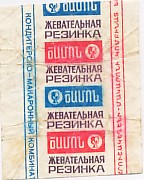 Actually
the very first Soviet chewing gum was produced in 1977 by Yerevan Sweets
and Macaroni Factory, Armenia. Though labeled as "chewing gum" it had quite
a few in common with real gums for it was made of by-products of macaroni
production and therefore actually contained no chicle. The gum was grayish-brown
in color, hard as an old sole and dissolved completely in one's mouth after
some intensive chewing.
Actually
the very first Soviet chewing gum was produced in 1977 by Yerevan Sweets
and Macaroni Factory, Armenia. Though labeled as "chewing gum" it had quite
a few in common with real gums for it was made of by-products of macaroni
production and therefore actually contained no chicle. The gum was grayish-brown
in color, hard as an old sole and dissolved completely in one's mouth after
some intensive chewing.
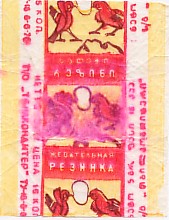 Soon
afterwards the Tbilisi Confectionery, Georgia, took its turn and started
its own gum production, with the only difference from low-quality Yerevan's
product being poor design of the filmy wrapper, where the inscriptions
were practically invisible. There wasn't any real gum base in those gums,
too.
Soon
afterwards the Tbilisi Confectionery, Georgia, took its turn and started
its own gum production, with the only difference from low-quality Yerevan's
product being poor design of the filmy wrapper, where the inscriptions
were practically invisible. There wasn't any real gum base in those gums,
too.
In 1978 the first imported gum production line was installed
and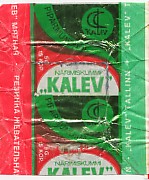
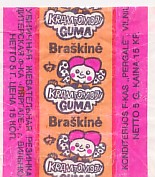 put
into operation at Kalev Confectionery in Tallinn. The next year another
line started working at Pergale Conf. in Vilnius. Both factories were located
near the Baltic Sea in Estonia and Lithuania accordingly because
all the raw materials for them were to be imported from abroad.
put
into operation at Kalev Confectionery in Tallinn. The next year another
line started working at Pergale Conf. in Vilnius. Both factories were located
near the Baltic Sea in Estonia and Lithuania accordingly because
all the raw materials for them were to be imported from abroad.
At first the assortment of production of those lines was quite limited. Both factories produced chewing gum in cubes with three flavors only: mint, orange and strawberry. The retail price of those gums was everywhere the same – 15 kopecks per piece, which was equal to 0.20 $. The quality of Estonian and Lithuanian gums was much higher than of Caucasian ones, though now one could place them somewhere between Syrian or Turkish products. Nonetheless every time they appeared in Moscow shops they caused long queues of customers and were usually sold in dozens or even whole 100-piece boxes for very profitable re-selling somewhere in the province.
By mid-1979 the chewing gum production lines and factories were operating almost in every republic and region of the European part of the USSR. The bulk of them was located in the southern part of the country, near to the Black Sea resorts and Caucasian spas. The European Soviet republics like Latvia, Byelorussia, Ukrania as well as Azerbaijan, Kazakhstan and Uzbekistan in Asia joined the race, too.

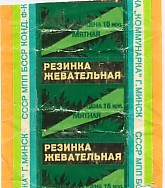
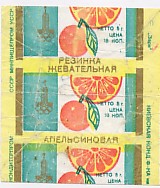
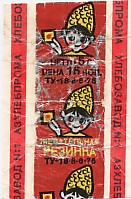
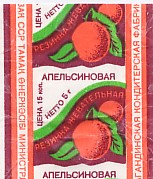

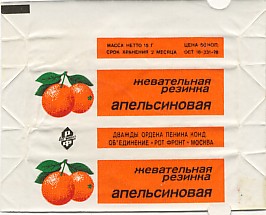
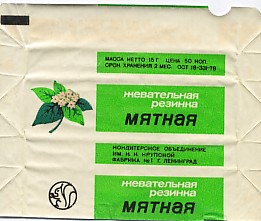 Almost
everywhere, though, the flavors of gums and designs of wrappers were very
much alike. Except for big cities like Moscow and Leningrad the gums were
produced in cubes with mint or orange flavor only. The 5-stick packets
were produced in Tallinn, Moscow and Leningrad, and the
flavor range wasn't much wider.
Almost
everywhere, though, the flavors of gums and designs of wrappers were very
much alike. Except for big cities like Moscow and Leningrad the gums were
produced in cubes with mint or orange flavor only. The 5-stick packets
were produced in Tallinn, Moscow and Leningrad, and the
flavor range wasn't much wider. 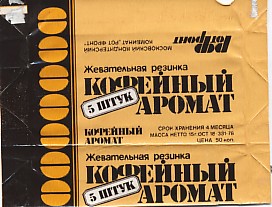
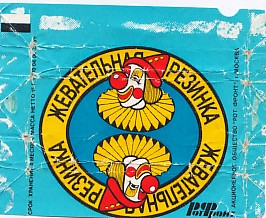 Besides
mint and orange the stick gums were produced with coffee and strawberry
flavors, too. The design of package wrappers differed only in the languages
used and the names of manufacturers with even the retail prices being the
same.
Besides
mint and orange the stick gums were produced with coffee and strawberry
flavors, too. The design of package wrappers differed only in the languages
used and the names of manufacturers with even the retail prices being the
same.

 As
for the prices it should be noted that during 1980 the stick gums produced
by Kalev Conf. in Tallinn and Rot Front Confectionery Amalgamation in Moscow
wore the Olympic logo on the packages for both these cities were the locations
of Olympic competitions. It caused 10 kopecks of extra pay for every package.
As
for the prices it should be noted that during 1980 the stick gums produced
by Kalev Conf. in Tallinn and Rot Front Confectionery Amalgamation in Moscow
wore the Olympic logo on the packages for both these cities were the locations
of Olympic competitions. It caused 10 kopecks of extra pay for every package.
New trends became visible after the Kuibyshev Confectionery (former name of Samara Conf.) started producing "Nu pogodi!" (Well you wait!) gum named after a popular Soviet cartoon in 5-stick packets using the well-known portraits of the cartoon heroes. Those gums became the hits of sales at once as children annoyed their parents, asking to buy exactly that gum with a picture of the Hare or the Wolf.
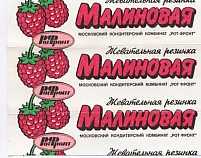
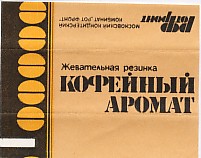 Since
1982 more picturesque and colorful wrapper designs were introduced at Kuibyshev,
Moscow, Yerevan and Tallinn gum factories. Raspberry flavor stick
gums won the hit-parade of that year, while the retail price dropped to
0.50 roubles due to the Olympic logo now unused.
Since
1982 more picturesque and colorful wrapper designs were introduced at Kuibyshev,
Moscow, Yerevan and Tallinn gum factories. Raspberry flavor stick
gums won the hit-parade of that year, while the retail price dropped to
0.50 roubles due to the Olympic logo now unused. 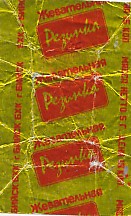 The
cube gums' prices varied from 0.10 to 0.20 roubles depending on their weight.
But bubble gums were still being brought to the country from abroad since
no such gums were produced in the USSR.
The
cube gums' prices varied from 0.10 to 0.20 roubles depending on their weight.
But bubble gums were still being brought to the country from abroad since
no such gums were produced in the USSR.
After Mr. Gorbachyov took offices and proclaimed the new
economic policy of "perestroika" lots of people tried their own business
in the Soviet Union. Some made shoes, some cured teeth, and some produced
chewing gums. While big factories had to overcome the mounting difficulties,
small private or collective-run shops flourished everywhere. 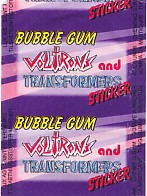
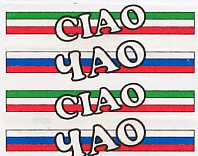 That
was the short but very fruitful "golden era" of Soviet gum production.
Almost every region of the USSR could boast its own chewing gum manufacturer
or even two. Usually the quality of those gums was below any imaginable
level with wrappers sometimes made of ordinary gray paper. But the variety
of gums was just amazing as the first Soviet bubble gums with inserts appeared.
That
was the short but very fruitful "golden era" of Soviet gum production.
Almost every region of the USSR could boast its own chewing gum manufacturer
or even two. Usually the quality of those gums was below any imaginable
level with wrappers sometimes made of ordinary gray paper. But the variety
of gums was just amazing as the first Soviet bubble gums with inserts appeared.
As the political discrepancies between the former Soviet
republics resulted in disintegration of the USSR in the end of 1991, the
gum production in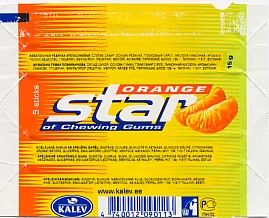 Russia and most of other republics was considerably reduced or terminated
due to the general economic crisis and was never to be revived in its previous
variety least in volume. The exception to this is Kalev, from Tallin, Estonia;
that is the only company that began in the Soviet era and reamains producing
chewing gums until now.
Russia and most of other republics was considerably reduced or terminated
due to the general economic crisis and was never to be revived in its previous
variety least in volume. The exception to this is Kalev, from Tallin, Estonia;
that is the only company that began in the Soviet era and reamains producing
chewing gums until now.
Within 1992-1996 all the gum factories in Russia were shut down. The period of so called "shuttles", or individual traders began as the people were allowed to travel abroad much easier than before. Those traders, many of them jobless women, visited Turkey and China sometimes as frequent as 20 times a year, to purchase cheap clothes, cosmetics, sweets and other goods to be re-sold at countless kiosks throughout the whole country. Canned beer, filter cigarettes, pantyhose, audiotapes as well as chewing gums from China, Turkey, Pakistan and Syria were sold at every corner.
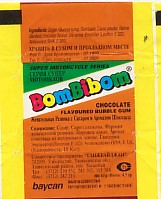
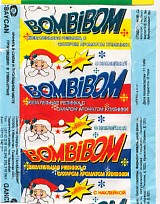
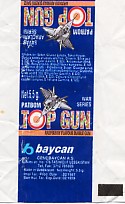
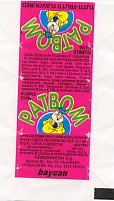 In
1997 Baycan Gida a.s. from Turkey established its first joint venture named
Genbaycan in Uzbekistan and started to produce the well-known Turkish
gum brands like "Bombibom" and "Top Gun" with original Turkish wrappers
and inserts nearby Tashkent. Soon the gums from Uzbekistan flooded the
adjacent countries and became available in Russia, too.
In
1997 Baycan Gida a.s. from Turkey established its first joint venture named
Genbaycan in Uzbekistan and started to produce the well-known Turkish
gum brands like "Bombibom" and "Top Gun" with original Turkish wrappers
and inserts nearby Tashkent. Soon the gums from Uzbekistan flooded the
adjacent countries and became available in Russia, too.
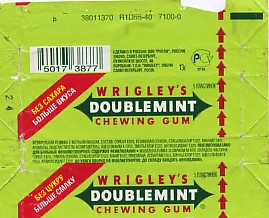
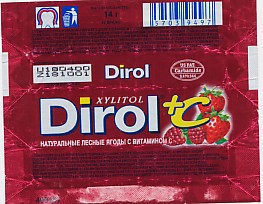 Then
the time of big sharks came as the two leading western gum producers, namely
Wrigley and Dandy, divided the spheres of activity in Russia and opened
their factories in St. Petersburg and Velikiy Novgorod under the names
of OOO "Wrigley" and ZAO "Dirol" accordingly. The import of their
gums from Europe was terminated soon after that.
Then
the time of big sharks came as the two leading western gum producers, namely
Wrigley and Dandy, divided the spheres of activity in Russia and opened
their factories in St. Petersburg and Velikiy Novgorod under the names
of OOO "Wrigley" and ZAO "Dirol" accordingly. The import of their
gums from Europe was terminated soon after that.

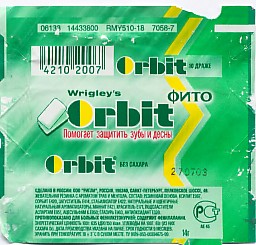
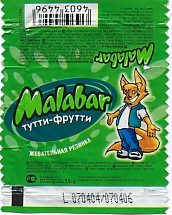
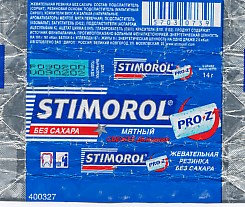
In 2000 and 2001 some new Russian companies like 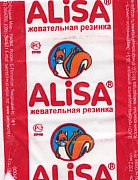
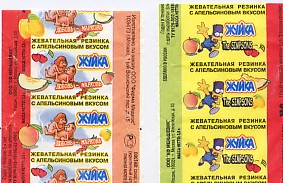 Menshevik
(Moscow) and Sladkiy Mir (St. Petersburg) were established. The tradition
of bubble gums with inserts continued with their products and even spread
into some new fashions never to be seen before in Russia like gum dragee
in transparent sacks or special sets consisting of a bubble gum, taso and
sticker in a pack.
Menshevik
(Moscow) and Sladkiy Mir (St. Petersburg) were established. The tradition
of bubble gums with inserts continued with their products and even spread
into some new fashions never to be seen before in Russia like gum dragee
in transparent sacks or special sets consisting of a bubble gum, taso and
sticker in a pack.
In 2002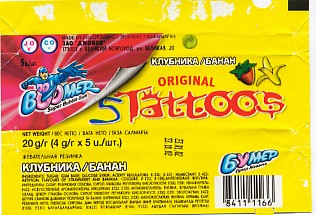
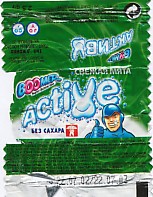 General Confiteria from Spain opened its joint venture Joyco in Novgorod.
The Spaniards followed the Turkish route and started to make their familiar
"Boomers" in slightly Russified wrappers. Soon the TV ads of Boomer appeared
on every channel of Russian television.
General Confiteria from Spain opened its joint venture Joyco in Novgorod.
The Spaniards followed the Turkish route and started to make their familiar
"Boomers" in slightly Russified wrappers. Soon the TV ads of Boomer appeared
on every channel of Russian television.
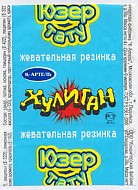
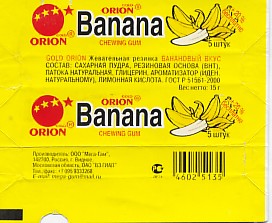 About
the same time some smaller producers went into the market, too. They are
K-Artel from Podolsk, Mega-gum from Vidnoye (both from Moscow region) and
a number of others. In the last years we witness the burst of gum production
in Russia (e-g. Andic, Firma Mak, and Enter Foods)
About
the same time some smaller producers went into the market, too. They are
K-Artel from Podolsk, Mega-gum from Vidnoye (both from Moscow region) and
a number of others. In the last years we witness the burst of gum production
in Russia (e-g. Andic, Firma Mak, and Enter Foods)
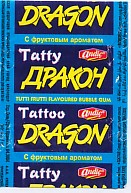
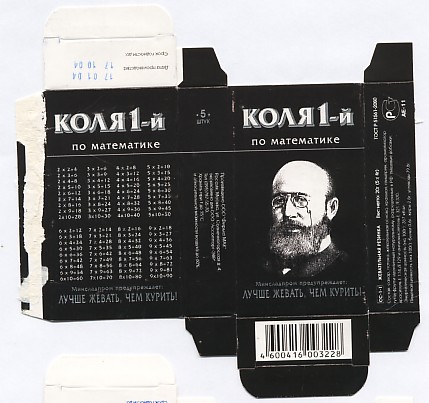
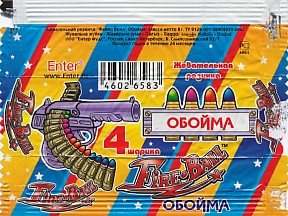
There is also the recent years production in other CIS countries (e.g. Neptun from Iljichovsk, Ukraine, Nur-Efsan from Tashkent, Uzbekistan ;Sultan, Civelek and Hamle from Kaskelen, Kazakhstan). This let us hope that the real "golden era" for gum collectors in Russia is still somewhere ahead.
